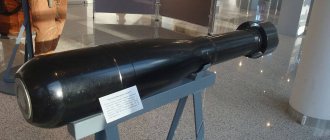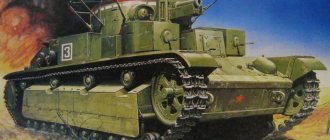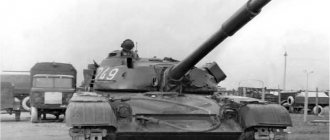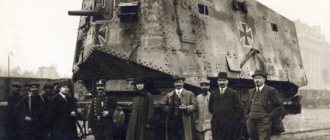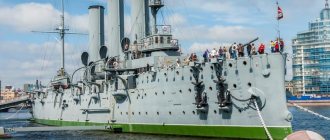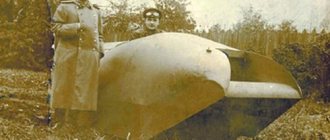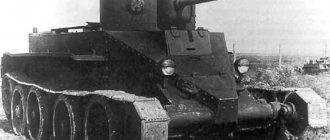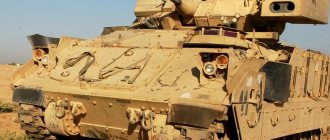Cruiser tank "Crusader"
Tank, Cruiser Crusader. Crusader - “crusader”, possible pronunciation: “Crusader” and “Crusader”.
The Crusader tank was developed in 1940 and represents a further development of the family of cruising tanks on a Christie-type tracked chassis. It has an almost classic layout: a liquid-cooled Nuffield Liberty gasoline engine is located in the rear of the hull, the fighting compartment is in the middle part, and the control compartment is in the front. A slight deviation from the classical design was the machine-gun turret, which was mounted on the first modifications in front, to the right of the driver. The main armament of the tank - a 40-mm cannon and a coaxial 7.92-mm machine gun - was installed in a circular rotation turret, which had large angles of inclination of armor plates up to 52 mm thick. The rotation of the tower was carried out using a hydraulic or mechanical drive. The body of the frame structure had frontal armor 52 mm thick and side armor 45 mm thick. To protect the chassis, armor screens were installed. Like all British cruising vehicles, the Crusader tank had a radio station and a tank intercom. The Crusader was produced in three successive modifications. The latest modification, the Crusader III, was produced until May 1942 and was armed with a 57 mm cannon. In total, about 4,300 Crusaders and 1,373 combat and auxiliary vehicles based on them (anti-aircraft self-propelled guns, repair and recovery vehicles, etc.) were produced. In 1942-1943. they were the standard armament of operational armored brigades.
Initial development of the A15 project ceased due to the uncertainty of the requirements themselves and resumed under the designation A16. Shortly after the approval of the wooden model of the A13 Mk III (Covenanter), presented in April 1939, the head of the Mechanization Directorate asked the General Staff to consider alternative designs that would be fully consistent with the heavy cruiser tank. These were the A18 (an enlarged modification of the Tetrarch tank), the A14 (developed by Landon Midland and Scottish Railway), the A16 (developed by Nuffield), as well as the “new” A15, which was intended to be an enlarged version of the A13Mk III.
The A15 was a clear favorite, since it used most of the components and assemblies of the A13 series tanks, including the Christie-type chassis, could therefore go into production faster, due to its greater length it covered wider ditches and had 30-40 mm armor, which gave it greater opportunities than other applicants. Nuffield proposed developing a tank based on the A13 M1s III with the chassis extended by one road wheel on each side. In June 1939, Nuffield proposed using the Liberty engine of the basic A13 instead of the Meadows of the A13 Mk III tank, since Liberty had already supplied the Nuffield to production but was not using it. This also promised weight reduction; the head of the Mechanization Department agreed and in July 1939 they issued the corresponding order for 200 tanks plus an experimental model. The last one was prepared by March 1940.
In mid-1940, the order for the A15 was increased to 400, then to 1062 vehicles, and Nuffield became the head of a group of nine companies involved in the production of the A15. Until 1943, total production reached 5,300 vehicles. "Childhood illnesses" of the prototype included poor ventilation, insufficient engine cooling and difficulty shifting gears. Production without extensive testing led to the fact that the Crusader, as it was called at the end of 1940, showed low reliability.
During the fighting in the desert, the Crusader tank became the main British tank from the spring of 1941. It first saw action at Capuzzo in June 1941 and participated in all subsequent battles in North Africa, and even at the outbreak of the Battle of El Alamein in October 1942 it remained in service with a 57 mm gun, although By that time it was already being replaced by the American MZ and M4.
The last Crusader tanks were finally withdrawn from combat units in May 1943, but this model was used as a training model until the end of the war. Since mid-1942, the Crusader chassis was adapted for various special vehicles, including self-propelled guns, artillery tractors and armored vehicles. When the Crusader was developed, it was too late to incorporate lessons from the fighting in France in 1940 into its design. In particular, the nose machine gun turret was eliminated due to its poor ventilation and limited effectiveness, as well as to simplify production. In addition, it became possible to slightly increase the thickness of the armor in the frontal part of the hull and turret. Finally, the Mk III was re-equipped from a 2-pounder to a 6-pounder.
The Germans praised its high speed, but it could not compete with the German Pz III with a 50-mm gun - its main opponent in the desert - in the thickness of its armor, its penetration and operational reliability. German 55mm, 75mm and 88mm anti-tank guns also easily hit Crusaders during desert battles.
Tactical and technical characteristics of the MK VI "Crusider III" tank
| Combat weight | 19.7 t |
| Dimensions: | |
| length | 5990 mm |
| width | 2640 mm |
| height | 2240 mm |
| Crew | 3 persons |
| Armament | 1 x 51 mm cannon 1 x 7.92 mm machine gun 1 × 7.69 anti-aircraft machine gun |
| Ammunition | 65 rounds 4760 rounds |
| Reservations: | |
| forehead of the body | 52 mm |
| forehead of the tower | 52 mm |
| engine's type | carburetor "Naffid-Liberty" |
| Maximum power | 345 hp |
| Maximum speed | 48 km/h |
| Power reserve | 160 km |
Modifications:
- "Crusider" I (cruising tank MK VI). Initial production model with 2-pounder gun.
- "Crusider" I C8 (cruising tank Mk VIС8). Same model, but with a 3-inch howitzer for use as a close fire support vehicle.
- "Crusider" II (cruising tank MK U1A). Similar to the Crusader I, but without the machine gun turret. Additional armor for the frontal part of the hull and turret.
- "Crusider" IS8 (cruising tank Mk U1A S8). Same as Crusader 1S8.
- Crusader III. The latest production modification with a 6-pounder gun and modified hull and turret armor. The prototype was tested in November-December 1941. In production from May 1942, by July 1942. 144 cars were assembled.
- "Crusader" OR (forward observer vehicle), "Crusader Command". Vehicles with a dummy gun, additional radio and communications equipment for forward artillery observers and senior officers, used after the Crusader was withdrawn from combat units.
- ZSU "Crusider" IIIAA Mk1. "Crusader" III with the installation of a 40-mm Bofors anti-aircraft gun instead of the turret. On the first vehicles, a conventional anti-aircraft installation was used without changes, then it was covered on all sides with armor plates, leaving the top open.
- ZSU "Crusider" III AA Mk11. "Crusider" III with the tank turret replaced by a new closed turret with a double-barreled 20-mm Oerlikon anti-aircraft gun. ZSU "Crusider" III AA Mk11. ZSU MkP, with a radio station located not in the turret, but in the front part of the hull (behind the mechanic - driver).
- ZSU "Crusider" AA with a three-barrel Oerlikon installation. Several vehicles were equipped with an open-top turret with a three-barrel 20-mm Oerlikon anti-aircraft gun. They were used only as training machines. These modifications of the ZSU were prepared for the invasion of northern Europe in 1944; ZSU units were introduced into each divisional headquarters company. However, Allied air superiority and rare enemy air attacks made SPA units not very necessary soon after the Normandy landings in June 1944.
- "Crusider" II artillery high-speed tractor Mk I. "Crusider" II with an open chute and a mount for stowing shots, was intended for towing a 17-pound (76.2 mm) anti-tank gun and its crew. Widely used in BTC anti-tank regiments during the European campaign in 1944-45. To overcome deep fords by vehicles of assault divisions in Operation Overlord, a special casing was installed.
- ARV "Crusider" AKU. Standard chassis without a turret, but with equipment for repairing equipment. The vehicle had a removable A-boom and a winch in place of the removed turret.
- Bulldozer "Crusader Dozer". Conversion of a standard tank for the Royal Corps of Engineers. Instead of a tower, a winch and a boom were installed, and a bulldozer blade was suspended on a frame mounted on the sides of the hull.
- Crusader Dozer and Crane (KOR). The Crusader Dozer, adapted for the needs of the Royal Ordnance Factory, was used to clear unexploded shells and mines. The bulldozer blade was held in a raised position as an armor shield, and additional armor plates were attached to the front of the hull.
Sources:
- M. Baryatinsky. “Crusader and others. (Armor Collection, 6 - 2005);
- G.L. Kholyavsky “Complete encyclopedia of tanks of the world 1915 - 2000”;
- Yu. F. Katorin. Tanks. Illustrated Encyclopedia;
- Crusader Cruiser 1939-45;
- Fletcher, David; Sarson, Peter. Crusader and Covenanter Cruiser Tank 1939-1945.
| < Back | Next > |
gun
In terms of armament, everything is also not so simple, and looking ahead I will say that in many ways the gun is far from comfortable. However, there are strengths here too, so let's talk about everything in order.
Crusader has
has a very modest alpha strike, but the rate of fire in our case is incredibly high, so without equipment and perks we can produce about 2050 units of damage per minute.
Penetrating the Crusader light tank
has good properties, but it is only enough to penetrate level 5 vehicles. Otherwise, you will need to drive into the opponents' sides and stern, and from time to time you will have to shoot gold, that is, having about 15-20 sub-calibers with you will not hurt.
The real weakness of our gun, without a doubt, can be called accuracy. Firstly, Crusader WoT
there is a large spread, secondly, our stabilization is poor, and also the aiming speed is absolutely not enough to achieve the aim between shots, because the rate of fire is hellish.
The “cherry” on this unusual tank will be the vertical aiming angles, since the barrel can only be lowered by 12 degrees from the side. If Crusader tank
looks forward, the declination angle is 7 degrees, and from the stern the gun practically does not lower at all.
Operators[edit]
- Argentina - converted artillery tractors
- Australia one squadron of the 9th Cavalry; North Africa (1941–43)
- at least one Crusader was tested in Australia (1941) by the 1st Armored Division.
. [20]
CONTENT
- 1 Design and development
- 2 Performance
- 3 Service history 3.1 North Africa
- 3.2 Other uses
- 4.1 Crusader I (Cruiser Mk VI)
- 8.1 Works Cited
Advantages and disadvantages
It is quite obvious that in order to play effectively on any tank, it is important to understand at least its main advantages and disadvantages, because based on this knowledge, you will be able to build battle tactics. Now we will highlight the strengths and weaknesses of Crusader World of Tanks
separately to make it easier for you to navigate. Pros: • Good overview; • Good mobility (but not sufficient for RT); • High level of camouflage • Excellent rate of fire and DPM; • Good, but capricious UVN. Cons: • Weak armor; • Small alphastrike; • Poor accuracy (scatter, convergence, stabilization); • Limited top speed.
Links[edit]
- ^ a b Boyd (2008).
- Bingham [ page needed
] - Fletcher, Universal Tank.
- p. 40; A15 Cruiser Mk. VI Crusader Tank: Technical History; PM Knight; Publications of the Black Prince
- Milsom, Sanders & Scarborough 1976, pp. 33-34.
- Neillands 1991, p. 79.
- Neillands 1991, p. 72.
- Milsom, Sanders & Scarborough 1976, p. 40.
- Milsom, Sanders & Scarborough 1976, p. 43.
- Milsom, Sanders & Scarborough 1976, p. 47.
- Milsom, Sanders & Scarborough 1976, p. 48.
- Green, Michael (October 30, 2014). Armored Warfare in the Vietnam War: Rare Photographs from the Wartime Archives. Pen & Sword Military. clause 9. ISBN 978-1-78159-381-3.
- ^ abc Chamberlain and Ellis, pp.
- ↑
Fletcher, pp. 65-66.sfn error: no target: CITEREFFletcher (help) - ↑
Fletcher, The Great Tank Scandal, p. 131. - Bingham [ page needed
] - ↑ Crusader Cruiser Tank
[
clarification needed
] page 43 - Fogliani [ page required
] - ↑ Crusader Cruiser Tank
[
clarification needed
] page 44 - Carruthers, Bob (2011). Tanks in the war 1939–1942
.
Wootton Waven: Coda Books. ISBN 978-1906783884.[ page required
] - ↑
Pierre-Olivier (November 1, 2010). "Surviving Cruiser Tanks" (PDF). Surviving Panzers website. Retrieved November 3, 2010.
Works Cited[edit]
- Bingham, James. Crusader: Cruiser Mark VI
. AFV Profile, No. 8. Windsor: Profile. OCLC 54349416. - Boyd, David (2008). "Crusader Tank". Equipment from World War II
. David Boyd. - Peter Chamberlain and Chris Ellis British and American Tanks of the Second World War, The Complete Illustrated History of British, American and Commonwealth Tanks 1933-1945
(1969) - Fletcher, David (1989). The Great Tank Scandal: British Armor in World War II - Part 1
. HMSO. ISBN 978-0-11-290460-1. - Fletcher, David (1989). The Universal Tank: British Armor in World War II - Part 2
. HMSO. ISBN 0-11-290534-X. - Fletcher, David; Sarson, Peter (2000). Crusader and Covenanter Cruiser Tank 1939–1945
.
New avant-garde. 14
. Botley: Osprey. ISBN 1-85532-512-8. - Fogliani, Segal; Jorge, Ricardo (1997). Blindados Argentinos, de Uruguay y Paraguay
(in Spanish). Buenos Aires: Ayer y Hoy Ediciones. ISBN 978-987-95832-7-2. - Milsom, John; Sanders, John; Scarborough, Gerald (1976). Crusader
.
Classic armored fighting vehicles. 1
. Yeovil: Patrick Stevens. ISBN 978-0-85059-194-1. - Neillands, Robin (1991). Desert Rats: 7th Armored Division, 1940–1945
. London: Weidenfeld and Nicholson. ISBN 978-0-297-81191-6.
